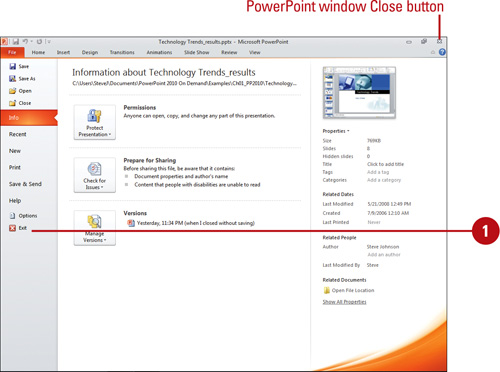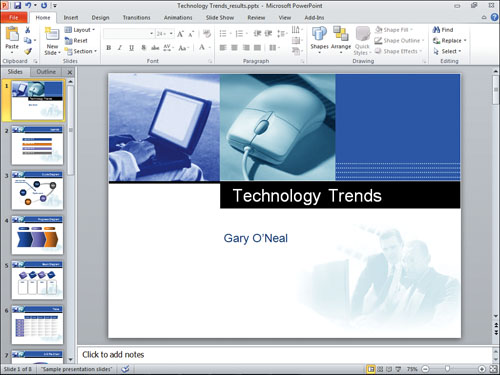1: Getting Started with PowerPoint
What You’ll Do
Create a Presentation Using a Template
Use Task Panes and Window Panes
Close a Presentation and Quit PowerPoint
Introduction
Whether you need to put together a quick presentation of sales figures for your management team or create a polished slide show for your company’s stockholders, Microsoft PowerPoint 2010 can help you present your information efficiently and professionally.
PowerPoint is a presentation graphics program—software that helps you create a slide show presentation and supplements, such as handouts and speaker’s notes. A slide show presentation is made up of a series of slides that can contain charts, diagrams, pictures, SmartArt graphs, bulleted lists, eye-catching text, multimedia video and audio clips, and more. PowerPoint is set up with a tab-based Ribbon and dialog boxes that provide you with the tools you need when you need them to get tasks done. The customizable Quick Access Toolbar gives you easy access to commonly-used commands, such as Save, Undo, and Redo.
PowerPoint provides a variety of professionally designed templates, themes, and style galleries to help you create great-looking presentations. When it comes time to develop your presentation, PowerPoint offers a selection of views and panes—Normal view, Slide Sorter view, Notes Page view, Reading view, and Slide Show view. Normal view is helpful for working on individual slides and notes, while Slide Sorter view helps you organize all of your slides and add transition elements. If you need to write extensive notes, Notes Page view provides the additional space you need. Reading and Slide Show view pulls it all together, allowing you to view your presentation on your computer monitor for fine tuning.
When you complete your presentation, you can save it in a more efficient PowerPoint XML format or as a PDF or XPS document, send it through e-mail for review, package it on a CD for clients, or even collaborate and share it with co-workers using a SharePoint slide library.
Starting PowerPoint
The two quickest ways to start PowerPoint are to select it on the Start menu or double-click a shortcut icon on the desktop. By providing different ways to start a program, Windows lets you work the way you like and start programs with a click of a button. When you start PowerPoint, a program window opens, displaying a blank presentation, where you can create a new presentation or open an existing one.
Start PowerPoint from the Start Menu
![]() Click the Start button on the taskbar.
Click the Start button on the taskbar.
![]() Point to All Programs.
Point to All Programs.
![]() Click Microsoft Office.
Click Microsoft Office.
![]() Click Microsoft PowerPoint 2010.
Click Microsoft PowerPoint 2010.
If Microsoft Office asks you to activate the program, follow the instructions to complete the process.
TIMESAVER To change the product key later, click the File tab, click Help, click the Change Product Key link, enter the product key, and then click Continue.
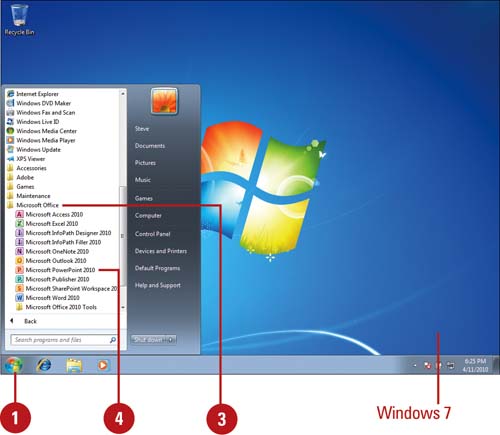
For Power Users
Need More PowerPoint 2010 Computing Power
If you’re a power user or analyst that needs to create bigger, more complex PowerPoint presentations, you should use the 64-bit version of Microsoft PowerPoint 2010 (New!). The 64-bit version of PowerPoint 2010 is built specifically for 64-bit computers. If you’re using the 32-bit version, PowerPoint 2010 significantly boosts performance levels (New!) over previous versions for importing, filtering, sorting, copying, and pasting large amounts of data as well as opening and saving large files.
Did You Know?
You can create a program shortcut from the Start menu to the desktop. Click the Start menu, point to All Programs, click Microsoft Office, right-click Microsoft PowerPoint 2010, point to Send To, and then click Desktop (Create Shortcut).
You can start PowerPoint and open a presentation from Windows Explorer. Double-clicking any PowerPoint presentation icon in Windows Explorer opens that file and PowerPoint.
Viewing the PowerPoint Window
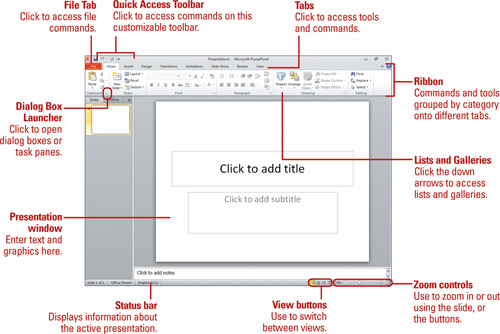
Using the Ribbon
The Ribbon is a results oriented way of working in PowerPoint 2010. It replaces menus, toolbars, and most of the task panes found in PowerPoint 2003. The Ribbon is located at the top of the document window and is comprised of tabs that are organized by task or objects. The controls on each tab are organized into groups, or subtasks. The controls, or command buttons, in each group execute a command, or display a menu of commands or a drop-down gallery. Controls in each group provide a visual way to quickly make document changes. The Office button in Office 2007 has been replaced by the File tab (New!), which displays Backstage view, where you can access file-related commands.
TIMESAVER To minimize the Ribbon, click the Minimize the Ribbon button (Ctrl+F1) (New!) or double-click the current tab. Click a tab to auto display it (Ribbon remains minimized). Click the Expand the Ribbon button (Ctrl+F1) or double-click a tab to maximize it.
If you prefer using the keyboard instead of the mouse to access commands on the Ribbon, Microsoft PowerPoint provides easy to use shortcuts. Simply press and release the ![]() or
or ![]() key to display KeyTips over each feature in the current view, and then continue to press the letter shown in the KeyTip until you press the one that you want to use. To cancel an action and hide the KeyTips, press and release the
key to display KeyTips over each feature in the current view, and then continue to press the letter shown in the KeyTip until you press the one that you want to use. To cancel an action and hide the KeyTips, press and release the ![]() or
or ![]() key again. If you prefer using the keyboard shortcuts found in previous versions of Microsoft PowerPoint, such as Ctrl+P (for Print), all the keyboard shortcuts and keyboard accelerators work exactly the same in Microsoft PowerPoint 2010.
key again. If you prefer using the keyboard shortcuts found in previous versions of Microsoft PowerPoint, such as Ctrl+P (for Print), all the keyboard shortcuts and keyboard accelerators work exactly the same in Microsoft PowerPoint 2010.
PowerPoint 2010 includes a legacy mode that you can turn on to use familiar PowerPoint 2003 keyboard accelerators.
Tabs
PowerPoint provides three types of tabs on the Ribbon. The first type is called a standard tab—such as Home, Insert, Review, View, and Add-Ins—that you see whenever you start PowerPoint. The second type is called a contextual tab—such as Picture Tools, Drawing, or Table—that appear only when they are needed based on the type of task you are doing. PowerPoint recognizes what you’re doing and provides the right set of tabs and tools to use when you need them. The third type is called a program tab that replaces the standard set of tabs when you switch to certain views or modes.
Live Preview
When you point to a gallery option, such as WordArt, on the Ribbon, PowerPoint displays a live preview of the option change so that you can see exactly what your change will look like before committing to it. The Paste Options button also displays a live preview for pasted content (New!).

Choosing Commands
PowerPoint commands are organized in groups on the Ribbon, Quick Access Toolbar, and Mini-Toolbar. Commands are available as buttons or options on the Ribbon, or as menus on buttons or option arrows or the File tab (New!). The Quick Access Toolbar and Mini-Toolbar display frequently used buttons that you may be already familiar with, while the File tab on the Ribbon displays file related menu commands in Back-stage view. In addition to the File tab, you can also open a shortcut menu with a group of related commands by right-clicking an element.
Choose a Menu Command Using the File Tab
![]() Click the File tab on the Ribbon.
Click the File tab on the Ribbon.
![]() Click the command you want.
Click the command you want.
TIMESAVER You can use a shortcut key to choose a command. Press and hold down the first key and then press the second key. For example, press and hold the Ctrl key and then press S (or Ctrl+S) to select the Save command.
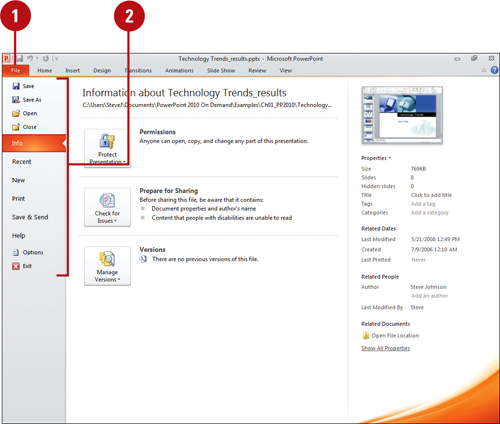
Choose a Menu Command from a Shortcut Menu
![]() Right-click an object (a cell or graphic element).
Right-click an object (a cell or graphic element).
TIMESAVER Press Shift+F10 to display the shortcut menu for a selected command.
![]() Click a command on the shortcut menu. If the command is followed by an arrow, point to the command to see a list of related options, and then click the option you want.
Click a command on the shortcut menu. If the command is followed by an arrow, point to the command to see a list of related options, and then click the option you want.
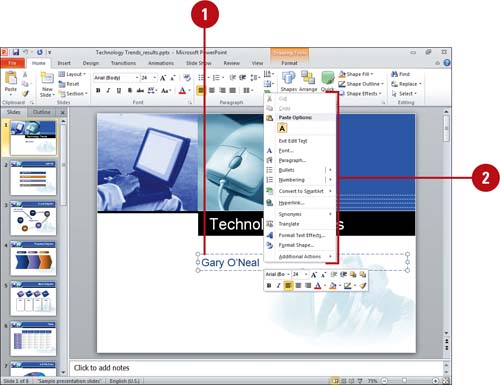
Working with Toolbars
PowerPoint includes its most common commands, such as Save and Undo, on the Quick Access Toolbar. Click a toolbar button to choose a command. If you are not sure what a toolbar button does, point to it to display a ScreenTip. When PowerPoint starts, the Quick Access Toolbar appears at the top of the window, unless you’ve changed your settings. You can customize the Quick Access Toolbar or Ribbon (New!) by adding command buttons or groups to it. You can also move the toolbar below or above the Ribbon so it’s right where you need it. In addition to the Quick Access Toolbar, PowerPoint also displays the Mini-Toolbar when you point to selected text. The Mini-Toolbar appears above the selected text and provides quick access to formatting tools.
Choose a Command Using a Toolbar or Ribbon
![]() Get command help. If you’re not sure what a button does, point to it to display a ScreenTip. If the ScreenTip includes Press F1 for more help, press F1.
Get command help. If you’re not sure what a button does, point to it to display a ScreenTip. If the ScreenTip includes Press F1 for more help, press F1.
![]() Choose a command. Click the button, or button arrow, and then click a command or option.
Choose a command. Click the button, or button arrow, and then click a command or option.
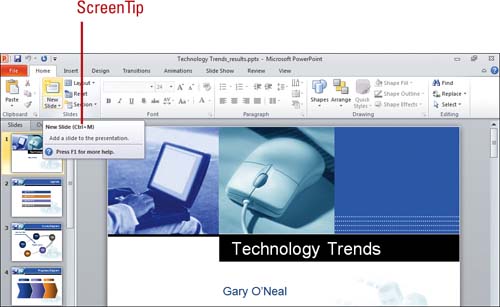
Add or Remove Items from the Quick Access Toolbar
![]() Add or remove a common button. Click the Customize Quick Access Toolbar list arrow, and then click a button name (checked item appears on the toolbar).
Add or remove a common button. Click the Customize Quick Access Toolbar list arrow, and then click a button name (checked item appears on the toolbar).
![]() Add a Ribbon button or group. Right-click the button or group name on the Ribbon, and then click Add to Quick Access Toolbar.
Add a Ribbon button or group. Right-click the button or group name on the Ribbon, and then click Add to Quick Access Toolbar.
![]() Remove a button or group. Right-click the button or group name on the Quick Access Toolbar, and then click Remove from Quick Access Toolbar.
Remove a button or group. Right-click the button or group name on the Quick Access Toolbar, and then click Remove from Quick Access Toolbar.
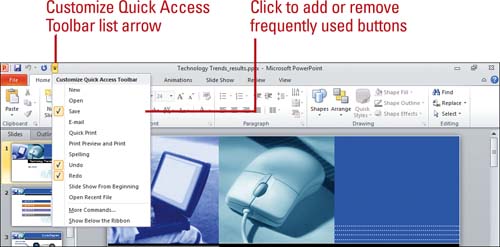
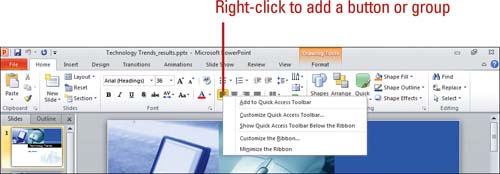
Customize the Ribbon or Quick Access Toolbar
![]() Click the File tab, and then click Options.
Click the File tab, and then click Options.
![]() Click the Customize Ribbon (New!) or Quick Access Toolbar.
Click the Customize Ribbon (New!) or Quick Access Toolbar.
![]() Click the Choose commands from list arrow, and then click All Commands or a specific Ribbon.
Click the Choose commands from list arrow, and then click All Commands or a specific Ribbon.
![]() Click the list arrow (right column), and then select the tabs or toolbar you want to change.
Click the list arrow (right column), and then select the tabs or toolbar you want to change.
![]() For the Ribbon, click New Tab to create a new tab, or click New Group to create a new group on the selected tab (right column).
For the Ribbon, click New Tab to create a new tab, or click New Group to create a new group on the selected tab (right column).
![]() To import or export a customized Ribbon or Quick Access Toolbar, click the Import/Export list arrow, select a command, and then select an import file or create an export file.
To import or export a customized Ribbon or Quick Access Toolbar, click the Import/Export list arrow, select a command, and then select an import file or create an export file.
![]() Click the command you want to add (left column) or remove (right column), and then click Add or Remove.
Click the command you want to add (left column) or remove (right column), and then click Add or Remove.
![]() To insert a separator line between buttons in the Quick Access Toolbar, click <Separator>, and then click Add.
To insert a separator line between buttons in the Quick Access Toolbar, click <Separator>, and then click Add.
![]() Click the Move Up and Move Down arrow buttons to arrange the order.
Click the Move Up and Move Down arrow buttons to arrange the order.
![]() To reset the Ribbon or Quick Access Toolbar, click the Reset list arrow, and then select a reset option.
To reset the Ribbon or Quick Access Toolbar, click the Reset list arrow, and then select a reset option.
![]() Click OK.
Click OK.
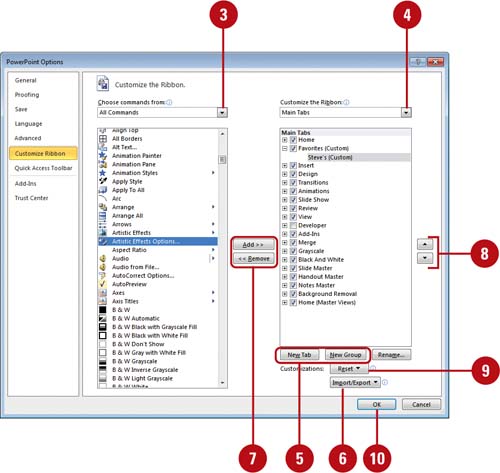
For Your Information
Moving Toolbars and the Ribbon
You can move the Quick Access Toolbar to another location. Click the Customize Quick Access Toolbar list arrow, and then click Show Below The Ribbon or Show Above The Ribbon. You can minimize the Ribbon (New!). Click the Minimize The Ribbon (Ctrl+F1) button on the right side of the Ribbon (to the left of the Help button). Click the Expand The Ribbon button to maximize it. When the Ribbon is minimized, you can click a tab to auto maximize it. When you click an option or in the document, the Ribbon minimizes again. Just like an auto-hide option.
Changing ScreenTips
You can turn off or change ScreenTips. Click the File tab, click Options, click General, click the ScreenTip Style list arrow, click Don’t Show Feature Descriptions In ScreenTips or Don’t Show ScreenTips, and then click OK.
Choosing Dialog Box Options
A dialog box is a window that opens when you click a Dialog Box Launcher. Dialog Box Launchers are small icons that appear at the bottom corner of some groups. When you point to a Dialog Box Launcher, a ScreenTip with a thumbnail of the dialog box appears to show you which dialog box opens. A dialog box allows you to supply more information before the program carries out the command you selected. After you enter information or make selections in a dialog box, click the OK button to complete the command. Click the Cancel button to close the dialog box without issuing the command. In many dialog boxes, you can also click an Apply button to apply your changes without closing the dialog box.
Choose Dialog Box Options
All dialog boxes contain the same types of options, including the following:
![]() Tabs. Click a tab to display its options. Each tab groups a related set of options.
Tabs. Click a tab to display its options. Each tab groups a related set of options.
![]() Option buttons. Click an option button to select it. You can usually select only one.
Option buttons. Click an option button to select it. You can usually select only one.
![]() Up and down arrows. Click the up or down arrow to increase or decrease the number, or type a number in the box.
Up and down arrows. Click the up or down arrow to increase or decrease the number, or type a number in the box.
![]() Check box. Click the box to turn on or off the option. A checked box means the option is selected; a cleared box means it’s not.
Check box. Click the box to turn on or off the option. A checked box means the option is selected; a cleared box means it’s not.
![]() List box. Click the list arrow to display a list of options, and then click the option you want.
List box. Click the list arrow to display a list of options, and then click the option you want.
![]() Text box. Click in the box and type the requested information.
Text box. Click in the box and type the requested information.
![]() Button. Click a button to perform a specific action or command. A button name followed by an ellipsis (…) opens another dialog box.
Button. Click a button to perform a specific action or command. A button name followed by an ellipsis (…) opens another dialog box.
![]() Preview box. Many dialog boxes show an image that reflects the options you select.
Preview box. Many dialog boxes show an image that reflects the options you select.
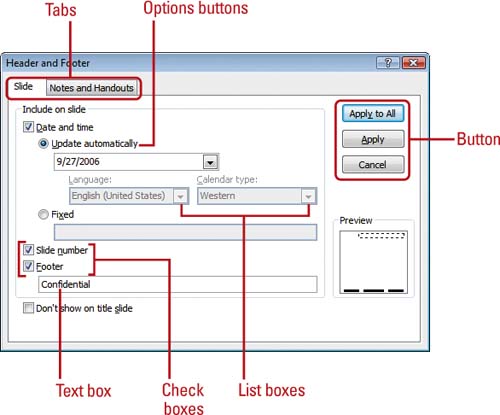
For Your Information
Navigating a Dialog Box
Rather than clicking to move around a dialog box, you can press the Tab key to move from one box or button to the next. You can also use Shift+Tab to move backward, or Ctrl+Tab and Ctrl+Shift+Tab to move between dialog box tabs.
Using the Status Bar
The Status bar appears across the bottom of your screen and displays presentation information—slide number, Office theme name, and current slide display zoom percentage—and some PowerPoint controls, such as view shortcut buttons, zoom slider, and Fit To Window button. With the click of the mouse, you can quickly customize exactly what you see on the Status bar. In addition to displaying information, the Status bar also allows you to check the on/off status of certain features, including Signatures, Permissions, and Macro Playback.
Add or Remove Items from the Status Bar
![]() Add Item. Right-click the Status bar, and then click an unchecked item.
Add Item. Right-click the Status bar, and then click an unchecked item.
![]() Remove Item. Right-click the Status bar, and then click a checked item.
Remove Item. Right-click the Status bar, and then click a checked item.
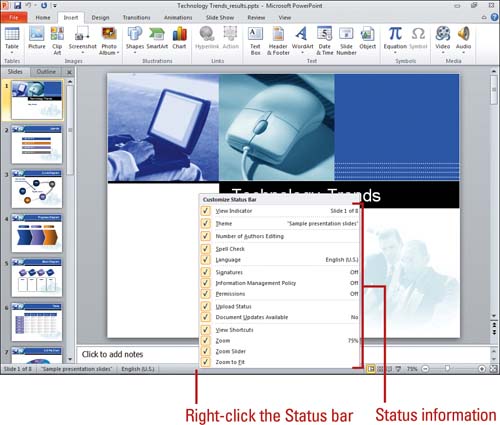
See Also
See “Adding a Digital Signature” on page 368 or “Simplifying Tasks with Macros” on page 408 for information on changing the status of items on the Status bar.
Creating a Blank Presentation
If you are not sure how you want your presentation to look, you can start a new presentation from scratch. You can create a blank presentation when you first start PowerPoint or after you have already started PowerPoint. Either way, a blank presentation appears, ready for you to use. When you create a new presentation, PowerPoint names them Presentation1, Presentation2, etc. until you save and name them. The presentation name appears on the title bar and taskbar buttons.
Start a Blank Presentation
![]() Start PowerPoint.
Start PowerPoint.
A blank presentation appears when you first open PowerPoint.
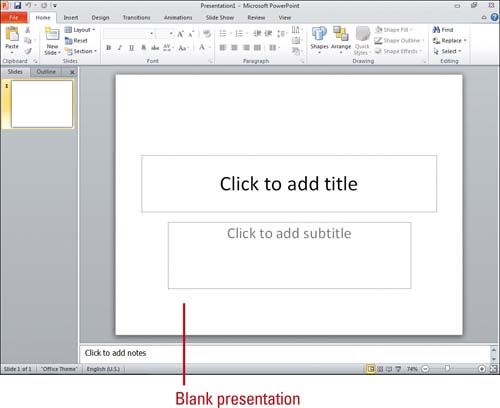
See Also
See “Viewing and Applying a Theme” on page 96 for information on creating a consistent look for a blank presentation.
Start a Blank Presentation Within PowerPoint
![]() Click the File tab, and then click New.
Click the File tab, and then click New.
TIMESAVER To create a blank presentation without the New screen, press Ctrl+N.
The New screen appears, displaying new presentation options.
![]() Click Blank presentation.
Click Blank presentation.
![]() Click Create.
Click Create.
A new blank presentation appears in the PowerPoint window.
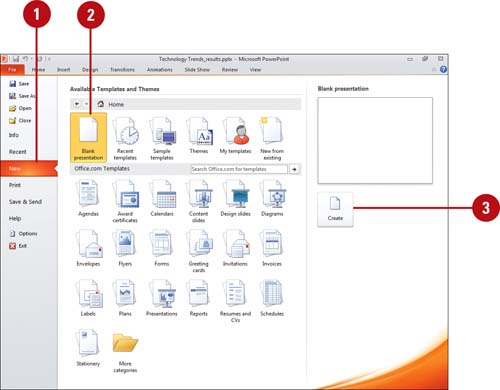
Creating a Presentation Using a Template
PowerPoint provides a collection of professionally designed templates that you can use to help you create presentations. Start with a template when you have a good idea of your content but want to take advantage of a template’s professional look. A template is a PowerPoint presentation file (.potx) that provides you with a unified presentation design, which includes layouts, themes and slide masters, so you only need to add text and graphics. In the New screen, you can choose a template from those already installed with PowerPoint or from Microsoft Office.com, an online content library. You can choose a Microsoft Office Online template from one of the listed categories, and then download it to your computer.
Create a Presentation with a Template
![]() Click the File tab, and then click New.
Click the File tab, and then click New.
![]() Choose one of the following:
Choose one of the following:
![]() Click the Recent templates icon to open recently used templates.
Click the Recent templates icon to open recently used templates.
![]() Click the Sample templates icon, and then click a sample template.
Click the Sample templates icon, and then click a sample template.
![]() Click the My templates category to open a dialog box.
Click the My templates category to open a dialog box.
![]() Click the Themes icon, and then click a design theme.
Click the Themes icon, and then click a design theme.
![]() Click an Office.com template category icon, click a folder as needed, and then click a template.
Click an Office.com template category icon, click a folder as needed, and then click a template.
![]() Click Create or Download.
Click Create or Download.
![]() If necessary, click the template you want, and then click OK.
If necessary, click the template you want, and then click OK.
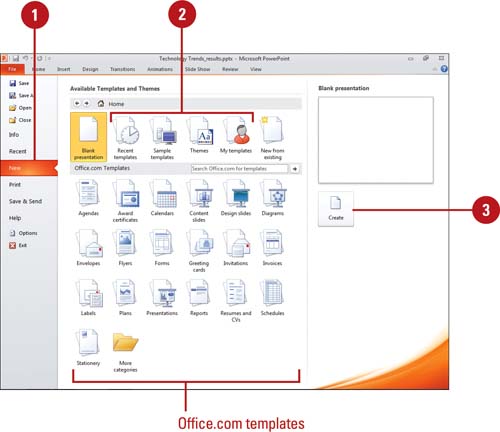

Did You Know?
You can download template packs on the Web. Go to www.microsoft.com, click the Office link, and then search for PowerPoint Templates.
Opening a Presentation
You can open an existing PowerPoint document by using the File tab (New!). On the File tab, you can choose the Open command to locate and select the document you want or choose a recently used document from the Recent Presentations or Recent Places list on the Recent screen (New!). Similar to the Windows Start menu, the Recent Presentations or Recent Places list allow you to pin documents to the list that you want to remain accessible regardless of recent use. The Pin icon to the right of the file name on the File tab makes it easy to pin or unpin as needed. When you open a document from PowerPoint 97-2003, PowerPoint 2010 goes into compatibility mode—indicated on the title bar—where it disables new features that cannot be displayed or converted well by previous versions. The document stays in compatibility mode until you convert it to the PowerPoint 2010 file format.
Open a Presentation
![]() Click the File tab, and then click Open.
Click the File tab, and then click Open.
![]() If you want to open a specific file type, click the Files of type list arrow, and then click a file type.
If you want to open a specific file type, click the Files of type list arrow, and then click a file type.
![]() If the file is located in another folder, click the Look In list arrow, and then navigate to the file.
If the file is located in another folder, click the Look In list arrow, and then navigate to the file.
![]() Click the PowerPoint file you want, and then click Open, or click the Open button arrow, and then click one of the following options:
Click the PowerPoint file you want, and then click Open, or click the Open button arrow, and then click one of the following options:
![]() Open Read-Only to open the selected file with protection.
Open Read-Only to open the selected file with protection.
![]() Open as Copy to open a copy of the selected file.
Open as Copy to open a copy of the selected file.
![]() Open in Browser to open the selected Web file in a browser.
Open in Browser to open the selected Web file in a browser.
![]() Open in Protected View to open the selected file in protected view (New!).
Open in Protected View to open the selected file in protected view (New!).
![]() Open and Repair to open the damaged file.
Open and Repair to open the damaged file.
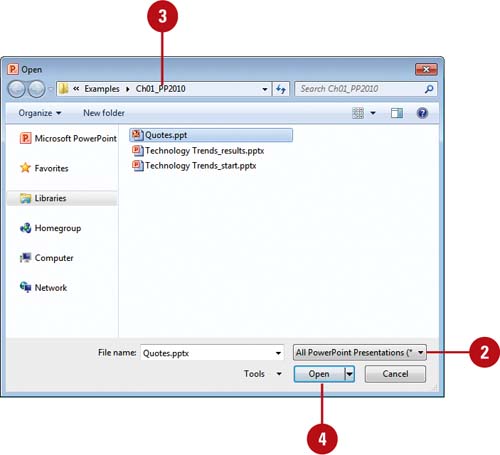
For Your Information
Using the Office Program Viewer
An Office program Viewer—PowerPoint, Word, and Excel—is a program used to open and view Office documents on computers that don’t have Microsoft Office installed. The Office program Viewer is available for download from the Microsoft Office Online Web site in the downloads section. Check the Microsoft Web site for software requirements.
Open a Recently Opened Document
![]() Click the File tab, and then click Recent.
Click the File tab, and then click Recent.
![]() Click the document you want to open in the Recent Presentations list or a folder in the Recent Places list.
Click the document you want to open in the Recent Presentations list or a folder in the Recent Places list.
![]() Pin a document/folder. Click the Pin icon (right-side) to display a green pin (document is pinned) on the Recent Presentations or Recent Places list (New!).
Pin a document/folder. Click the Pin icon (right-side) to display a green pin (document is pinned) on the Recent Presentations or Recent Places list (New!).
![]() Unpin a document/folder. Click the Pin icon (right-side) to display a grey pin on the Recent Presentations or Recent Places list (New!).
Unpin a document/folder. Click the Pin icon (right-side) to display a grey pin on the Recent Presentations or Recent Places list (New!).
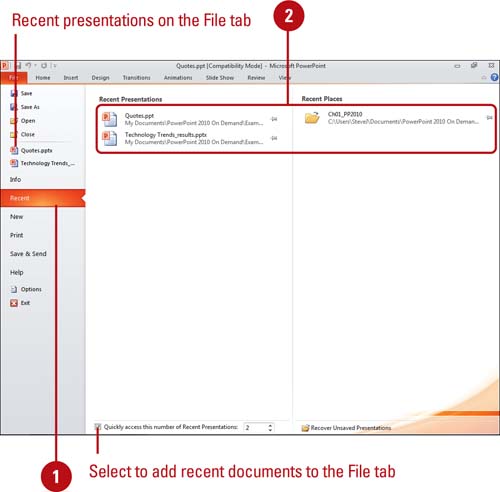
For Your Information
Managing Files in the Open or Save Dialog
When you open the Open or Save As dialog box, you can manage files directly in the dialog box. You can delete or rename a file in a dialog box. In the Open or Save As dialog box, click the file, click the Tools list arrow (XP) or the Organize button (7 or Vista), and then click Delete or Rename. You can also quickly move or copy a file in a dialog box. In the Open or Save As dialog box, right-click the file you want to move or copy, click Cut or Copy, open the folder where you want to paste the file, right-click a blank area, and then click Paste.
Did You Know?
You can add recently used documents to the File tab (New!). Click the File tab, click Recent, select the Quickly Access This Number Of Recent Documents check box, and then specify the number of documents you want to display.
You can change the number of recently opened files that appear on the File tab. Click the File tab, click Options, click Advanced, change the Show This Number Of Recent Documents list, and then click OK.
You can change the default file location of the Open dialog box. Click the File tab, click Options, click Save, enter a new location in the Default File Location box, and then click OK.
Arranging Windows
Each presentation opens inside a separate PowerPoint window (New!), which contains a title bar and a work area. Most often, you’ll probably fill the entire screen with one window. But when you want to move or copy information between programs or documents, it’s easier to display several windows at once. You can arrange two or more windows from one program or from different programs on the screen at the same time. However, you must make the window active to work in it. In PowerPoint you can use window commands on the View tab to arrange or switch between presentation windows. You can also click the PowerPoint buttons on the taskbar to switch between open presentations.
Resize and Move a Window
![]() Maximize button. Click to make a window fill the entire screen.
Maximize button. Click to make a window fill the entire screen.
![]() Restore Down button. Click to reduce a maximized window to a reduced size.
Restore Down button. Click to reduce a maximized window to a reduced size.
![]() Minimize button. Click to shrink a window to a taskbar button. To restore the window to its previous size, click the taskbar button.
Minimize button. Click to shrink a window to a taskbar button. To restore the window to its previous size, click the taskbar button.
![]() Close button. Click to shut a window.
Close button. Click to shut a window.

Arrange or Switch Between Windows
![]() Open the presentations you want to arrange or switch between.
Open the presentations you want to arrange or switch between.
![]() Click the View tab.
Click the View tab.
![]() In the Window group, click:
In the Window group, click:
![]() Switch Windows, and then click the presentation name you want.
Switch Windows, and then click the presentation name you want.
![]() Arrange All to fit the windows on the screen.
Arrange All to fit the windows on the screen.
![]() Cascade Windows to arrange windows diagonally.
Cascade Windows to arrange windows diagonally.
![]() New Window to open a new window containing a view of the current presentation.
New Window to open a new window containing a view of the current presentation.
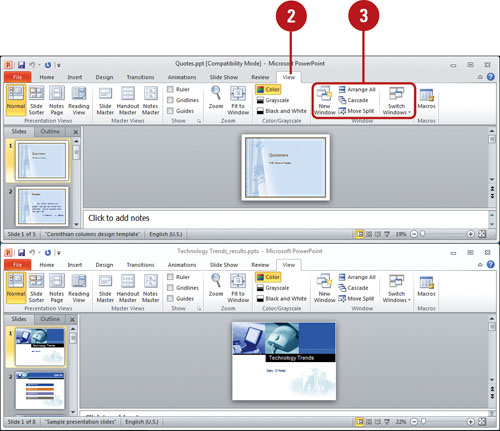
Using Task Panes and Window Panes
Task panes are separate windows that appear when you need them, such as the Navigation pane, or when you click a Dialog Box Launcher icon, such as Office Clipboard and Clip Art. A task pane displays various options that relate to the current task. Window panes are sections of a window, such as the Slides and Outline pane and Notes pane in Normal view. If you need a larger work area, you can use the Close button in the upper-right corner of the pane to close a task or window pane, or move a border edge (for task panes) or splitter (for window panes) to resize it.
Work with Task and Window Panes
![]() Open a Task Pane. It appears when you need it or when you click a Dialog Box Launcher icon.
Open a Task Pane. It appears when you need it or when you click a Dialog Box Launcher icon.
![]() Close a Task or Window Pane. Click the Close button in upper-right corner of the pane.
Close a Task or Window Pane. Click the Close button in upper-right corner of the pane.
![]() Resize a Task Pane. Point to the Task Pane border edge until the pointer changes to double arrows, then drag the edge to resize it.
Resize a Task Pane. Point to the Task Pane border edge until the pointer changes to double arrows, then drag the edge to resize it.
![]() Resize a Window Pane. Point to the window pane border bar until the pointer changes to a double bar with arrows, then drag the edge to resize it.
Resize a Window Pane. Point to the window pane border bar until the pointer changes to a double bar with arrows, then drag the edge to resize it.
IMPORTANT To open the Slides and Outline pane after you close it, drag the border edge near the left edge of the PowerPoint window to the right.
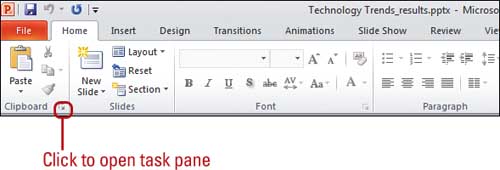
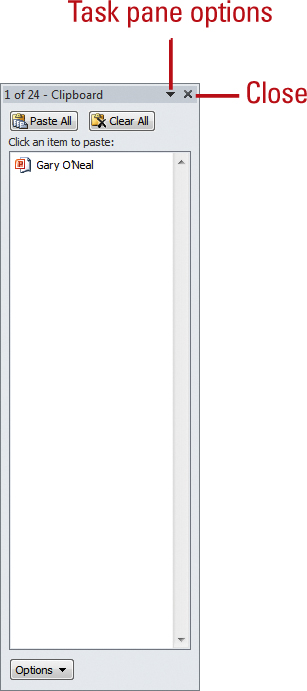
Did You Know?
You can resize window panes using the keyboard. Click the View tab, click the Move Split button in the Window group, use the arrow keys to move the splitters and then press Enter to return to the document.
Understanding PowerPoint Views
To help you during all phases of developing a presentation, PowerPoint provides four different views: Normal, Slide Sorter, Reading (New!) and Slide Show. You can switch from one view to another by clicking a view button located on the Status bar or by using the buttons in the Presentation Views group on the View tab. In any view, you can use the Zoom feature on the Status bar to increase and decrease the page view size and display the slide to fit the screen.
Normal view
Use the Normal view to work with the three underlying elements of a presentation—the outline, slide, and notes—each in its own pane. These panes provide an overview of your presentation and let you work on all of its parts. You can adjust the size of the panes by dragging the pane borders. You can use the Outline pane to develop and organize your presentation’s content. Use the Slides pane to add text, graphics, movies, sounds, and hyperlinks to individual slides, and the Notes pane to add speaker notes or notes you want to share with your audience.
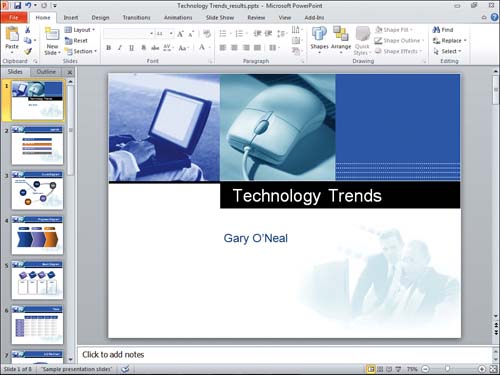
Outline pane
Use the Outline pane in Normal view to develop your presentation’s content. Individual slides are numbered and a slide icon appears for each slide.
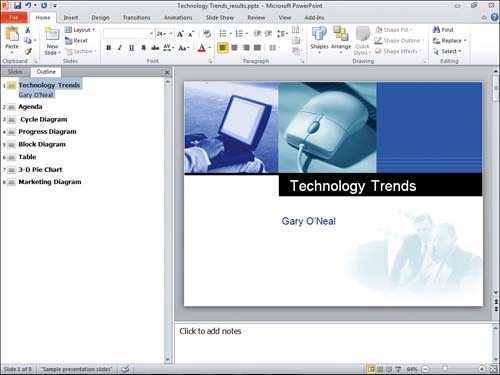
Slides pane
Use the Slides pane in Normal view to preview each slide. Click the slide you want to view. You can also move through your slides using the scroll bars or the Previous Slide and Next Slide buttons. When you drag the scroll box up or down on the vertical scroll bar, a label appears that indicates which slide will be displayed if you release the mouse button.
Slide Sorter view
Use the Slide Sorter view to organize your slides, add actions between slides—called slide transitions—and apply other effects to your slide show. The Transitions tab helps you add slide transitions and control your presentation. When you add a slide transition, you see an icon that indicates an action will take place as one slide replaces another during a show. If you hide a slide, you see an icon that indicates the slide will not be shown during the presentation.
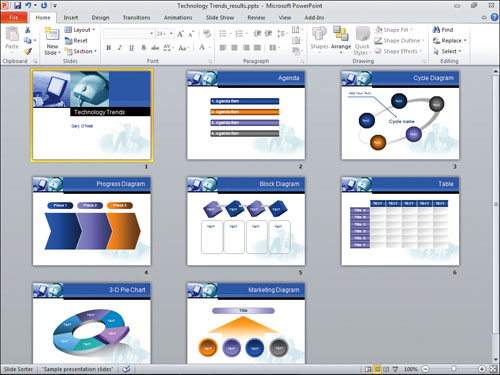
Reading view
Reading view (New!) presents your slides in a slide show one at a time in a separate window. Use this view when you’re ready to rehearse your presentation. This view is especially useful when you want to show two presentations in a slide show in separate windows at the same time.
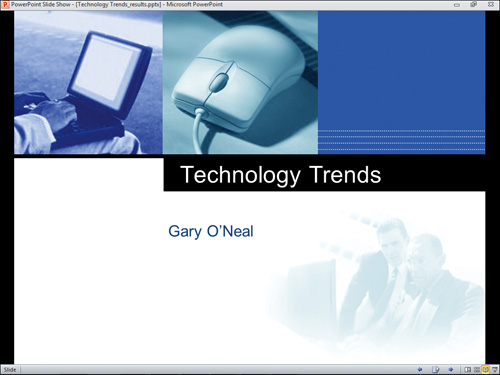
Slide Show view
Slide Show view presents your slides one at a time. Use this view when you’re ready to rehearse or give your presentation. To move through the slides, click the screen, or press Enter to move through the show.

Browsing a Presentation
You might want to browse through a completed presentation to view the contents and design of each slide and to evaluate the types of slides in a presentation in several ways. When a slide doesn’t fit the screen, you can change the presentation view size, or click the scroll arrows to scroll line by line or click above or below the scroll box to scroll window by window and move to another slide. To move immediately to a specific slide, you can drag the scroll box. In Slides pane, you can click the Next Slide and Previous Slide buttons, which are located at the bottom of the vertical scroll bar, to switch between slides in a presentation.
Browse Through a Presentation
![]() Click the Up scroll arrow or Down scroll arrow to scroll line by line.
Click the Up scroll arrow or Down scroll arrow to scroll line by line.
When you scroll to the top or bottom of a slide, you automatically move to the previous or next page.
![]() Click above or below the Scroll box to scroll window by window.
Click above or below the Scroll box to scroll window by window.
![]() Drag the Scroll box to move immediately to a specific slide.
Drag the Scroll box to move immediately to a specific slide.
As you drag, a slide indicator box appears, telling you the slide number and title.
![]() Click the Previous Slide or Next
Click the Previous Slide or Next
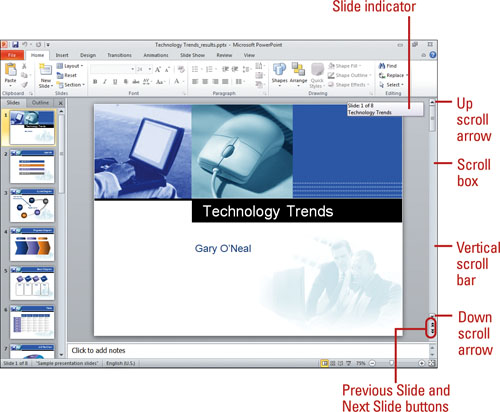
Did You Know?
You can use the keyboard to browse slides. Press the Page Up or Page Down key to switch between slides. If you use these keys, the slides in the Slides pane will change also.
Browse Through Slides or an Outline
![]() In Normal view, click the Outline or Slides tab.
In Normal view, click the Outline or Slides tab.
![]() Click the Up scroll arrow or Down scroll arrow to scroll line by line.
Click the Up scroll arrow or Down scroll arrow to scroll line by line.
The slide doesn’t change as you scroll.
![]() Click a slide icon or slide miniature to display the slide.
Click a slide icon or slide miniature to display the slide.
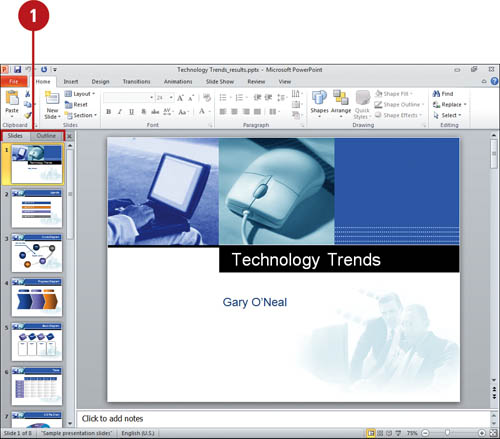
Change Presentation View Size
![]() Click the zoom percentage on the Status bar, click the option size you want, and then click OK.
Click the zoom percentage on the Status bar, click the option size you want, and then click OK.
![]() Click the Zoom In (+) or Zoom Out (-) buttons on the Status bar.
Click the Zoom In (+) or Zoom Out (-) buttons on the Status bar.
![]() Drag the Zoom slider on the Status bar.
Drag the Zoom slider on the Status bar.
![]() Click the Fit To Window button to resize the slide to the current window.
Click the Fit To Window button to resize the slide to the current window.
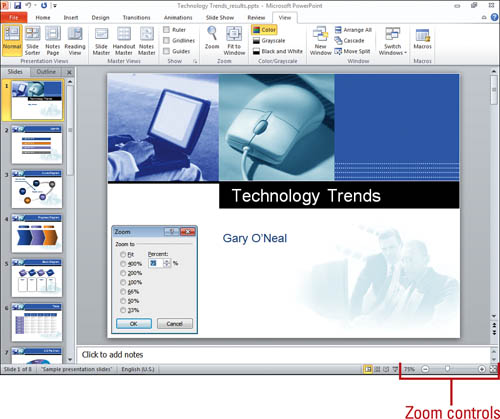
Documenting Properties
PowerPoint automatically documents properties while you work—such as file size, save dates, and various statistics—and allows you to document other properties, such as title, author, subject, keywords, category, and status. You can view or edit standard document properties or create advanced custom properties by using the Document Information Panel, which is an XML-based Microsoft InfoPath form hosted in the Office program. You can use document properties—also known as metadata—to help you manage and track files; search tools can use the metadata to find a document based on your search criteria. If you associate a document property to an item in the document, the document property updates when you change the item.
View and Edit Document Properties
![]() Click the File tab, and then click Info.
Click the File tab, and then click Info.
![]() To display other properties, click the Properties button, and then select an option:
To display other properties, click the Properties button, and then select an option:
![]() Show Document Panel. Shows Document panel in the document.
Show Document Panel. Shows Document panel in the document.
![]() Advanced Properties. Displays the Properties dialog box.
Advanced Properties. Displays the Properties dialog box.
![]() Enter the standard properties, such as author, title, subject, keywords, category, status, and comments.
Enter the standard properties, such as author, title, subject, keywords, category, status, and comments.
![]() Show All Properties. Click the link to displays more options.
Show All Properties. Click the link to displays more options.
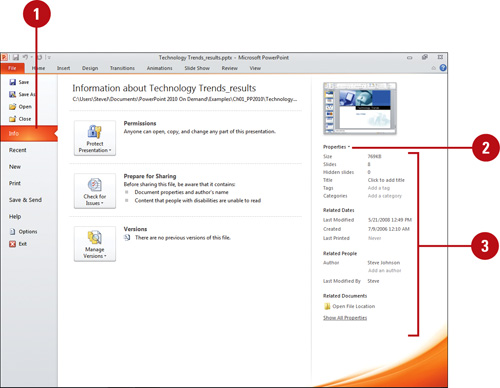
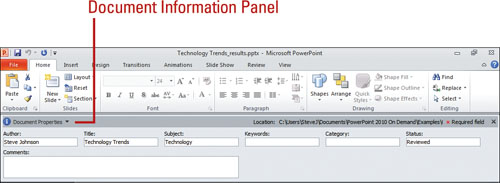
Did You Know?
You can view or change document properties when you open or save a file. In the Open or Save As dialog box, select the document you want, click the arrow next to the Views, and then click Details to view file size and last changed date, or click Properties to view all information. If you want to insert or change author names or keywords, click the Authors box or Tags box, and then type what you want.
Converting an Existing Document
When you open a document from PowerPoint 97-2003, PowerPoint 2010 goes into compatibility mode—indicated on the title bar—where it disables new features that cannot be displayed or converted well by previous versions. When you save a document, PowerPoint 2010 saves PowerPoint 97-2003 files in their older format using compatibility mode. The document stays in compatibility mode until you convert it using the Save As dialog box to the PowerPoint 2010 file format with the same or different name.
Convert a PowerPoint 97-2003 Presentation to PowerPoint 2010
![]() Open the PowerPoint presentation 97-2003 you want to convert to the PowerPoint 2010 file format.
Open the PowerPoint presentation 97-2003 you want to convert to the PowerPoint 2010 file format.
The PowerPoint document opens in compatibility mode.
![]() Click the File tab, and then click Info.
Click the File tab, and then click Info.
![]() Click Convert.
Click Convert.
![]() Click the Save in list arrow, and then click the drive or folder where you want to save the file.
Click the Save in list arrow, and then click the drive or folder where you want to save the file.
![]() Type a presentation file name.
Type a presentation file name.
![]() Click Save to convert the file to the PowerPoint 2010 format.
Click Save to convert the file to the PowerPoint 2010 format.
PowerPoint exits compatibility mode, which is only turned on when a previous version is in use.
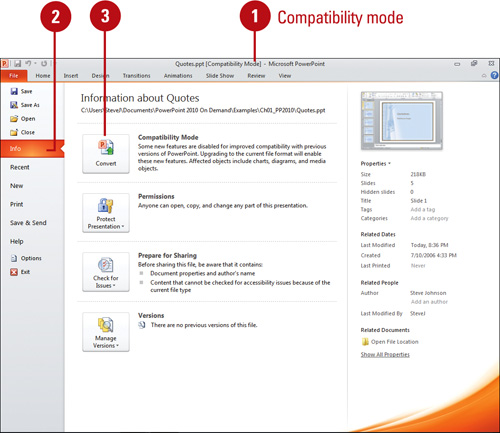
Did You Know?
You can display extensions in the Save and Open dialog boxes and Recent Presentations list. Changing the Windows option also changes PowerPoint. In the Folder Options dialog box on the View tab, clear the Hide Extensions For Known File Types check box, and then click OK.
Getting Help While You Work
At some time, everyone has a question or two about the program they are using. The Office Help Viewer provides the answers and resources you need, including feature help, articles, tips, templates, training, and downloads. By connecting to Microsoft Office Online, you not only have access to standard product help information, but you also have access to updated information over the Web without leaving the Help Viewer. The Web browser-like Help Viewer allows you to browse an extensive catalog of topics using a table of contents to locate information, or ask a question or enter phrases to search for specific information. When you use any of these help options, a list of possible answers is shown to you with the most likely answer or most frequently-used at the top of the list.
Use the Help Viewer to Get Answers
![]() Click the Help button on the Ribbon.
Click the Help button on the Ribbon.
TIMESAVER Press F1.
![]() Locate the Help topic you want.
Locate the Help topic you want.
![]() Click a Help category on the home page, and then click a topic (? icon).
Click a Help category on the home page, and then click a topic (? icon).
![]() Click the Show/Hide Table of Contents button on the toolbar, click a help category (book icon) and then click a topic (? icon).
Click the Show/Hide Table of Contents button on the toolbar, click a help category (book icon) and then click a topic (? icon).
![]() Read the topic, and then click any links to get Help information.
Read the topic, and then click any links to get Help information.
![]() Click the Back, Forward, Stop, Refresh, and Home buttons on the toolbar to move around in the Help Viewer.
Click the Back, Forward, Stop, Refresh, and Home buttons on the toolbar to move around in the Help Viewer.
![]() If you want to print the topic, click the Print button on the toolbar.
If you want to print the topic, click the Print button on the toolbar.
![]() To keep the Help Viewer window (not maximized) on top or behind, click to toggle the Keep On Top button (pin pushed in) and Not On Top button (pin not pushed in) on the toolbar.
To keep the Help Viewer window (not maximized) on top or behind, click to toggle the Keep On Top button (pin pushed in) and Not On Top button (pin not pushed in) on the toolbar.
![]() When you’re done, click the Close button.
When you’re done, click the Close button.
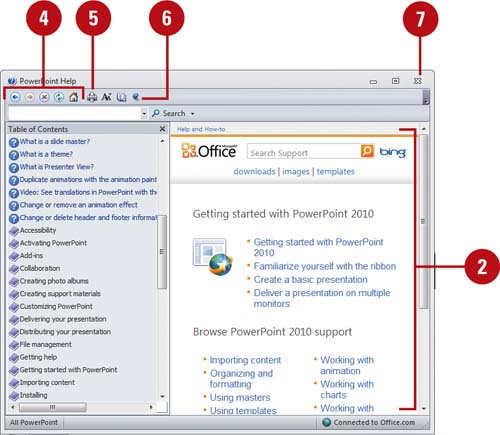
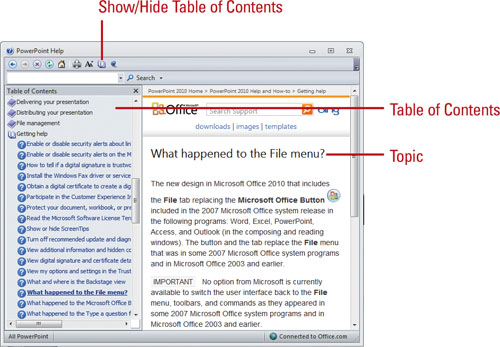
![]() Click the Help button on the Ribbon.
Click the Help button on the Ribbon.
![]() Click the Search button list arrow below the toolbar, and then select the location and type of information you want.
Click the Search button list arrow below the toolbar, and then select the location and type of information you want.
![]() Type one or more keywords in the Search For box, and then click the Search button.
Type one or more keywords in the Search For box, and then click the Search button.
![]() Click a topic.
Click a topic.
![]() Read the topic, and then click any links to get information on related topics or definitions.
Read the topic, and then click any links to get information on related topics or definitions.
![]() When you’re done, click the Close button.
When you’re done, click the Close button.

Check Help Connection Status
![]() Click the Help button on the Ribbon.
Click the Help button on the Ribbon.
![]() Click the Connection Status at the bottom of the Help Viewer.
Click the Connection Status at the bottom of the Help Viewer.
![]() Click the connection option where you want to get help information:
Click the connection option where you want to get help information:
![]() Show content from Office.com to get help from this computer and the internet (online).
Show content from Office.com to get help from this computer and the internet (online).
![]() Show content only from this computer to get help from this computer only (offline).
Show content only from this computer to get help from this computer only (offline).
This setting is maintained for all Office 2010 program Help Viewers.
![]() When you’re done, click the Close button.
When you’re done, click the Close button.
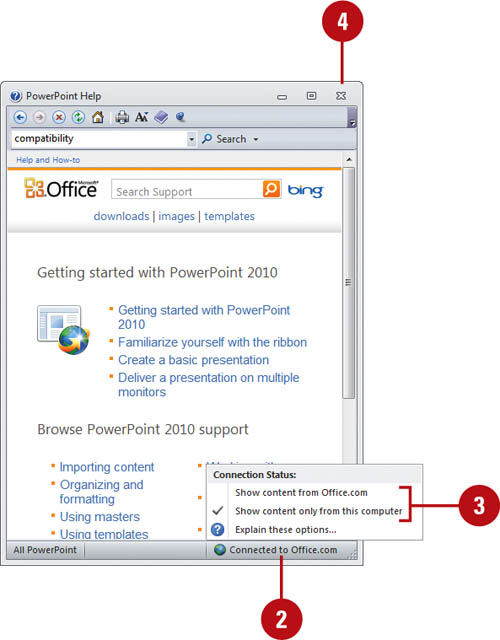
Saving a Presentation
After you create a PowerPoint presentation, save it as a file on your computer so you can work with it later. When you save a presentation for the first time or if you want to save a copy of a file, use the Save As command. When you want to save an open presentation, use the Save button on the Quick Access Toolbar. When you save a presentation, PowerPoint 2010 saves PowerPoint 97-2003 files in their older format using compatibility mode and new PowerPoint 2010 files in an XML (Extensible Markup Language) based file format .pptx. The XML format significantly reduces file sizes, provides enhanced file recovery, and allows for increased compatibility, sharing, reuse, and transportability. A PowerPoint 97-2003 presentation stays in compatibility mode—indicated on the title bar—until you convert it to the new PowerPoint 2010 file format. Compatibility mode disables new features that cannot be displayed or converted well by previous versions.
Save a Presentation for PowerPoint 2010
![]() Click the File tab, and then click Save As.
Click the File tab, and then click Save As.
TIMESAVER Press Ctrl+S to save a document in its current format.
![]() Click the Save in list arrow, and then click the drive or folder where you want to save the file.
Click the Save in list arrow, and then click the drive or folder where you want to save the file.
![]() Type a presentation file name.
Type a presentation file name.
![]() Click the Save as type list arrow, and then click PowerPoint Presentation.
Click the Save as type list arrow, and then click PowerPoint Presentation.
![]() Click the Authors or Tags box to enter Document Properties.
Click the Authors or Tags box to enter Document Properties.
![]() Click Save.
Click Save.
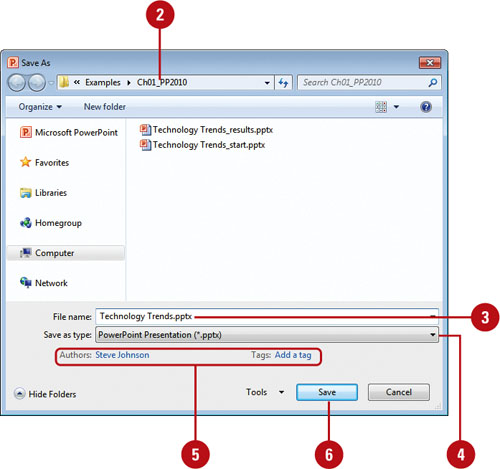
Did You Know?
You can access options from the Save dialog box. In the Save dialog box, click Tools, and then click the command option you want, either Save Options, General Options, or Compress Pictures.
Save a PowerPoint 97-2003 Presentation in Compatibility Mode
![]() Open the PowerPoint 97-2003 presentation you want to continue to save in the 97-2003 format.
Open the PowerPoint 97-2003 presentation you want to continue to save in the 97-2003 format.
The PowerPoint presentation opens in compatibility mode.
![]() Click the Save button on the Quick Access Toolbar, or click the File tab, and then click Save.
Click the Save button on the Quick Access Toolbar, or click the File tab, and then click Save.
PowerPoint stays in compatibility mode.
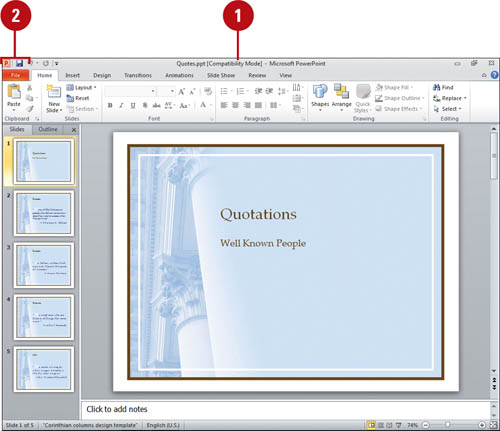
Set Save Options
![]() Click the File tab, and then click Options.
Click the File tab, and then click Options.
![]() In the left pane, click Save.
In the left pane, click Save.
![]() Set the save options you want:
Set the save options you want:
![]() Default Save Format. Click Save files in this format list arrow, and then click the default format you want.
Default Save Format. Click Save files in this format list arrow, and then click the default format you want.
![]() Default File Location. Specify the complete path to the folder location where you want to save your presentation.
Default File Location. Specify the complete path to the folder location where you want to save your presentation.
![]() Click OK.
Click OK.
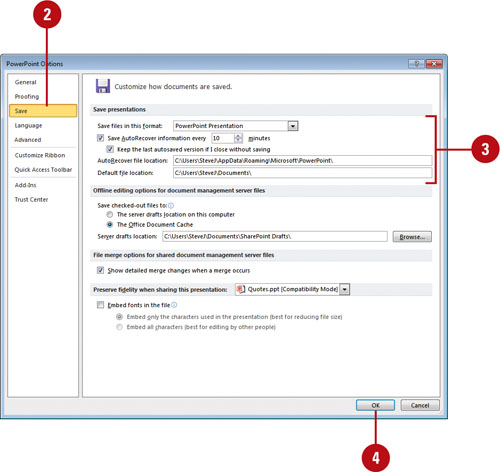
Saving a Presentation with Different Formats
PowerPoint is a versatile graphics presentation program that allows you to save your presentation in a variety of different formats—see the table on the following page for a complete list and description. For example, you might want to save your presentation as a picture presentation or individual slides as graphic files. Or you can save a document in an earlier 97-2003 version in case the people you work with have not upgraded to PowerPoint 2010. If you save a document to 97-2003, some new features and formatting are converted to uneditable pictures or not retained. The format is compatible with Office 2003, Office XP, and Office 2000 with a software patch. However, for best results, if you’re creating a document for someone with PowerPoint 97 to 2003, it’s better to save it with the .ppt file format.
Save a Presentation for PowerPoint 97-2003 or Other Format
![]() Click the File tab, and then click Save & Send.
Click the File tab, and then click Save & Send.
![]() Click Change File Type.
Click Change File Type.
![]() Click the file type you want.
Click the file type you want.
![]() Click the Save As button.
Click the Save As button.
The Save As dialog box opens with the selected file type.
![]() You can also click the File tab, click Save As, and then select a file format.
You can also click the File tab, click Save As, and then select a file format.
![]() Click the Save in list arrow, and then select the location where you want to save the file.
Click the Save in list arrow, and then select the location where you want to save the file.
![]() Type a file name.
Type a file name.
![]() Click Save.
Click Save.
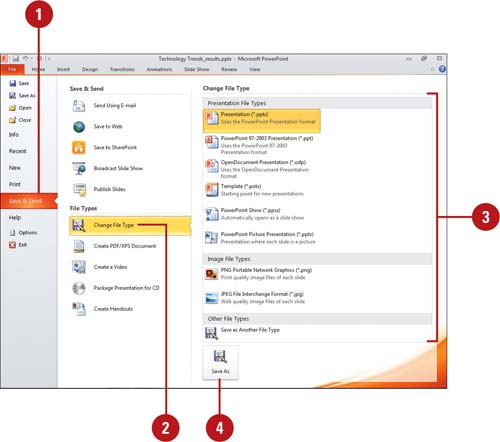
See Also
See “Creating a PDF Document” on page 305 or “Creating an XPS Document” on page 306 for information on saving presentations in other formats.
PowerPoint 2010 Supported File Formats

Recovering a Document
If PowerPoint encounters a problem and stops responding, the program automatically tries to recover the file. The recovered files are stored and managed by PowerPoint. You can use the Manage Versions button (New!) on the Info screen under the File tab to open any available recovered unsaved files. If you have a lot of recovered files, you can also delete all file versions to save disk space. To use the AutoRecover option, you need to enable it in the Save category of the Options dialog box. You can set AutoRecover options to periodically save a temporary copy of your current file, which ensures proper recovery of the file and allows you to revert to an earlier version of a file. In addition, if you didn’t save your changes when you closed a document, you can select an AutoRecover option to save your work as a safe guard (New!).
Recover or Revert a Document
![]() Click the File tab, and then click Info.
Click the File tab, and then click Info.
![]() To open a recovered or previous version, click a file from the available list.
To open a recovered or previous version, click a file from the available list.
![]() Click the Manage Versions button, and then click Recover Unsaved Presentations.
Click the Manage Versions button, and then click Recover Unsaved Presentations.
TIMESAVER Click the File tab, click Recent, and then click Recover Unsaved Presentations folder icon.
![]() Select the file version you want to recover.
Select the file version you want to recover.
![]() Click Open.
Click Open.
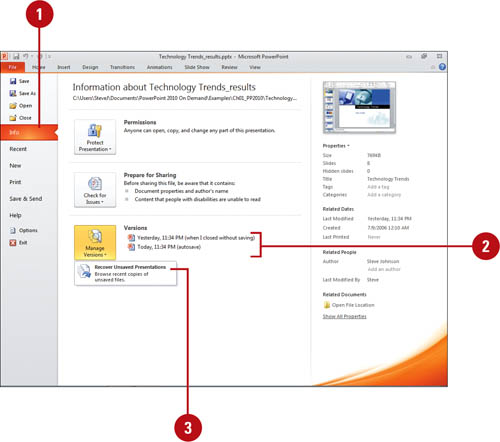
![]() Click the File tab, and then click Recent.
Click the File tab, and then click Recent.
![]() Click the Recover Unsaved Presentation button (New!).
Click the Recover Unsaved Presentation button (New!).
![]() Select the unsaved file you want to open from the Unsaved Files folder in the Office folder.
Select the unsaved file you want to open from the Unsaved Files folder in the Office folder.
![]() Click Open.
Click Open.
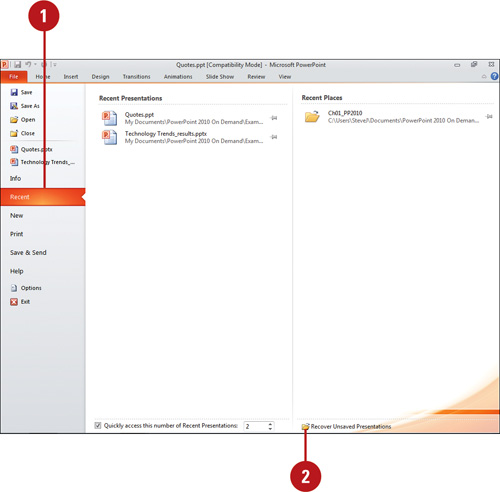
Use AutoRecover
![]() Click the File tab, and then click Options.
Click the File tab, and then click Options.
![]() In the left pane, click Save.
In the left pane, click Save.
![]() Select the Save AutoRecover information every x minutes check box.
Select the Save AutoRecover information every x minutes check box.
![]() Enter the number of minutes, or click the Up and Down arrows to adjust the minutes.
Enter the number of minutes, or click the Up and Down arrows to adjust the minutes.
![]() Select the Keep the last autosaved version if I close without saving check box as a safe guard to save your work if you don’t save it (New!).
Select the Keep the last autosaved version if I close without saving check box as a safe guard to save your work if you don’t save it (New!).
![]() Specify the complete path to the folder location where you want to save your AutoRecover file.
Specify the complete path to the folder location where you want to save your AutoRecover file.
![]() Click OK.
Click OK.
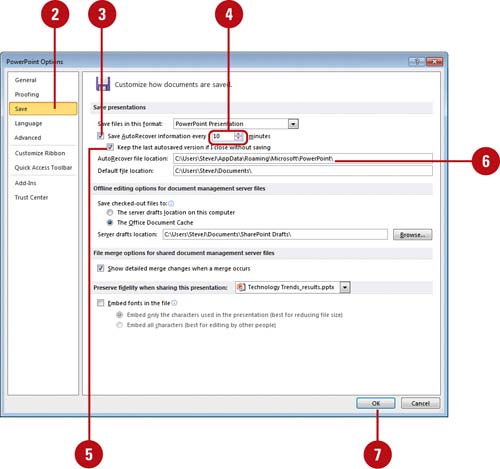
Maintaining and Repairing Office
At times you may determine that PowerPoint or another Office program is not working as efficiently as it once did. This sometimes happens when you install new software or move files into new folders. Office does the work for you with the Repair option, which locates, diagnoses, and fixes any errors in the program itself. Note that this feature does not repair personal files like documents, presentations, or workbooks. If the Repair option does not fix the problem, you might have to reinstall PowerPoint or Office. If you need to add or remove features, reinstall PowerPoint or Office, or remove it entirely, you can use Office Setup’s maintenance feature.
Perform Program Maintenance
![]() Insert the Office disc in your drive or navigate to the folder with the setup program.
Insert the Office disc in your drive or navigate to the folder with the setup program.
![]() In Windows Explorer, double-click the Setup icon.
In Windows Explorer, double-click the Setup icon.
![]() Click one of the following maintenance buttons.
Click one of the following maintenance buttons.
![]() Add or Remove Features to change which features are installed or remove specific features.
Add or Remove Features to change which features are installed or remove specific features.
![]() Remove to uninstall Microsoft Office 2010 from this computer.
Remove to uninstall Microsoft Office 2010 from this computer.
![]() Repair to repair Microsoft Office 2010 to its original state.
Repair to repair Microsoft Office 2010 to its original state.
![]() Enter a Product Key to type the product registration key (located in the product packaging) for Office 2010.
Enter a Product Key to type the product registration key (located in the product packaging) for Office 2010.
![]() Click Continue, and then follow the wizard instructions to complete the maintenance.
Click Continue, and then follow the wizard instructions to complete the maintenance.
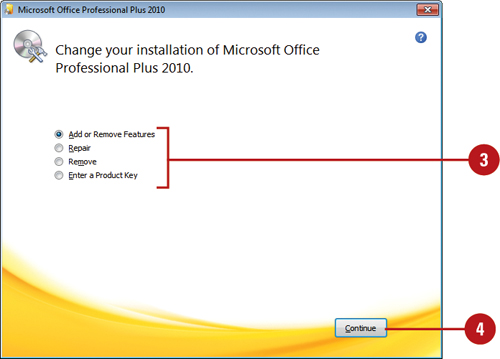
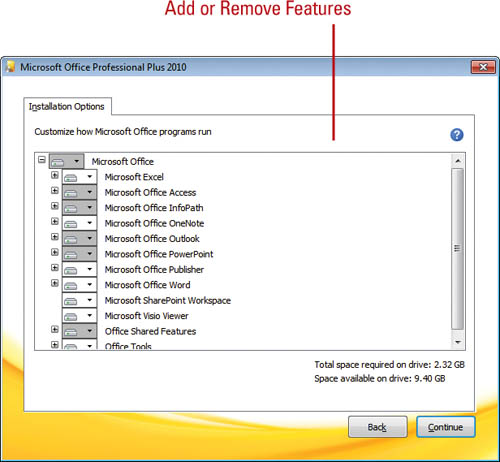
See Also
See “Working with Office Safe Modes” on page 384 for information on fixing problems with a Microsoft Office 2010 program.
Getting Updates on the Web
Microsoft offers a quick and easy way to update PowerPoint and any other Office program with new software downloads that improve the stability and security of the program. From the Help screen on the File tab, simply click the Check for Updates button to connect to the Microsoft Update Web site to have your computer scanned for necessary updates, and then choose which Office updates you want to download and install.
Get Office Updates on the Web
![]() Click the File tab, and then click Help.
Click the File tab, and then click Help.
![]() Click Check for Updates to open the Microsoft Update Web site.
Click Check for Updates to open the Microsoft Update Web site.
![]() Click one of the update buttons to find out if you need updates, and then choose the updates you want to download and install.
Click one of the update buttons to find out if you need updates, and then choose the updates you want to download and install.
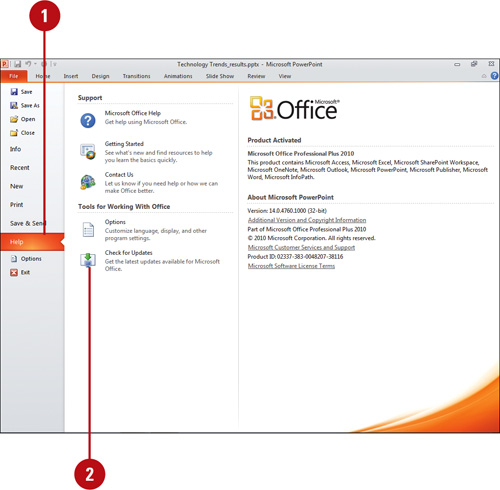
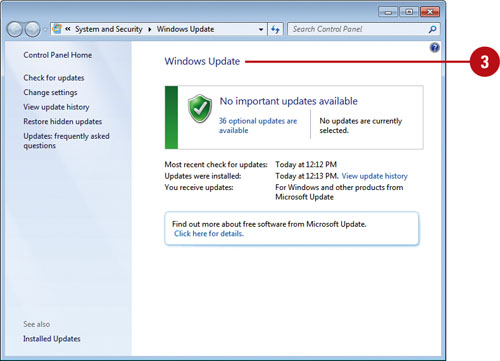
Did You Know?
You can contact Microsoft for help. You can get support over the phone, chat, or e-mail messages. To get online help, click the File tab, click Help, and then click Contact Us.
You can get better help information. At the bottom of a help topic, click Yes, No, or I Don’t Know to give Microsoft feedback on the usefulness of a topic.
Closing a Presentation and Quitting PowerPoint
After you finish working on a presentation, you can close it. Closing a file makes more computer memory available for other activities. Closing a presentation is different from quitting PowerPoint; after you close a presentation, PowerPoint is still running. When you’re finished using PowerPoint, you can quit the program. To protect your files, always save your presentations and quit PowerPoint before turning off the computer.
Close a Presentation
![]() Click the File tab, and then click Close.
Click the File tab, and then click Close.
TIMESAVER Press Ctrl+W.
![]() You can also click the Close button on the PowerPoint window to quickly close a presentation, however, if there’s only one presentation open, it exits PowerPoint.
You can also click the Close button on the PowerPoint window to quickly close a presentation, however, if there’s only one presentation open, it exits PowerPoint.
![]() If you have made changes to any open files since last saving them, a dialog box opens, asking if you want to save changes. Click Save to save any changes, or click Don’t Save to ignore your changes.
If you have made changes to any open files since last saving them, a dialog box opens, asking if you want to save changes. Click Save to save any changes, or click Don’t Save to ignore your changes.
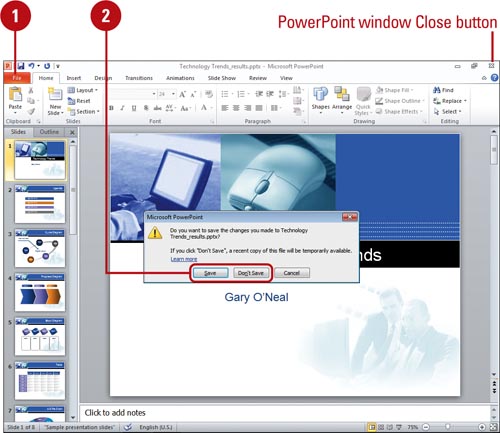
Exit PowerPoint
![]() Click the File tab, and then click Exit.
Click the File tab, and then click Exit.
TIMESAVER Press Ctrl+Q.
![]() If there’s only one presentation open, you can also click the Close button on the PowerPoint window to quickly exit.
If there’s only one presentation open, you can also click the Close button on the PowerPoint window to quickly exit.
![]() If you have made changes to any open files since last saving them, a dialog box opens asking if you want to save changes. Click Save to save any changes, or click Don’t Save to ignore your changes.
If you have made changes to any open files since last saving them, a dialog box opens asking if you want to save changes. Click Save to save any changes, or click Don’t Save to ignore your changes.
